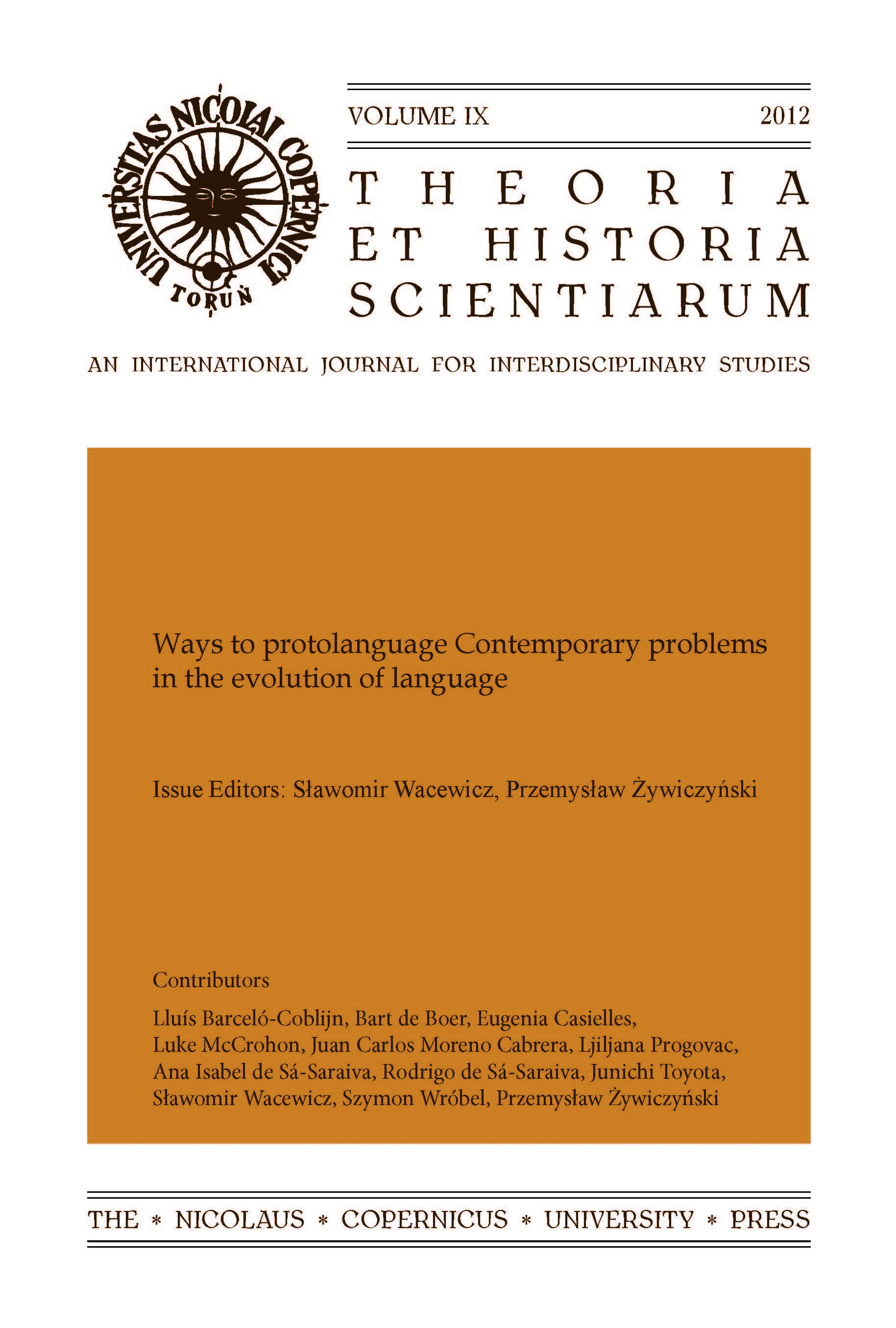The narrow faculty of language: What is it, who has it, and how is it defined?
DOI:
https://doi.org/10.12775/v10235-011-0012-3Abstract
The evolution of language, as a research area, is special in many ways. One of those ways is its inherently interdisciplinary status with its usual afflictions, i.e. the terminological barriers to fruitful communication of researchers with different backgrounds. The FLN/FLB concept, created with intent to improve this condition, has now become an influential but fundamentally confused bit of terminology, complicating rather than clarifying dialogue across disciplinary borders. The suggested overall conclusions are twofold. Firstly, researchers into language evolution should not accept the FLN/FLB distinction at face value, but rather refer meticulously to primary literature. Ultimately, it is hoped that the FLN/FLB distinction will be supplanted by a more compelling one, driven by a more coherent research agenda. Until then, FLN1, i.e. FLN as defined in Hauser et al. (2002), should probably be used, both for reasons of priority and theoretical usefulness. As a second point, it is astonishing that such a major conceptual inconsistency between the two definitions of FLN/FLB has remained essentially unnoticed or ignored. This may be due to the proclaimed “clarification” of this issue in Fitch et al. (2005); however, as has been demonstrated, this “clarification,” based on demonstrably false claims, only added to the confusion. It may signal a need for a radical top-down examination and discussion of the terminological-conceptual inventory of the evolution of language before this field develops its own tertiary literature.
Theoria et Historia Scientiarum
References
Armstrong, D. & Wilcox, S. (2007). The Gestural Origin of Language. Oxford: Oxford University Press.
Barceló-Coblijn, L. (This volume). Evolutionary Scenarios for the Emergence Of Recursion.
Botha, R. (2000). Discussing the evolution of the assorted beasts called language. Language & Communication 20, 149-160.
Christiansen, M. & Kirby, S. (2003a). Language Evolution: the Hardest Problem in Science? In M. Christiansen & S. Kirby (Eds.), Language Evolution (pp. 1-15). Oxford: Oxford University Press.
Christiansen, M. & Kirby, S. (2003b). Language evolution: consensus and controversies. Trends in Cognitive Sciences 7(7), 300-307.
Chomsky, N. (2007). Biolinguistic Explorations: Design, Development, Evolution. International Journal of Philosophical Studies 15, 1-21. [http://dx.doi.org/10.1080/09672550601143078]
Corballis, M. (2002). From Hand to Mouth: The Origins of Language. Princeton, NJ: Princeton University Press.
Fitch, T. (2005). The evolution of language: a comparative review. Biology and Philosophy 20, 193-230.
Fitch, T. (2010). The evolution of language. Cambridge: Cambridge University Press.
Fitch, T., Hauser, M. & Chomsky, N. (2005). The evolution of the language faculty: clarifications and implications. Cognition. 97(2), 179-210.
Hauser, M., Chomsky, N. & Fitch T. (2002). The Faculty of Language: What. Is It, Who Has It, and How Did It Evolve? Science 298, 1569-1579.
Hauser, M., Barner, D. & O’Donnell, T. (2007). Evolutionary linguistics: a new look at an old landscape. Language Learning, and Development, 3(2), 101-132.
Jackendoff, R. (1999). Possible stages in the evolution of the language capacity. Trends in Cognitive Sciences, 3(7), 272-279.
Johansson, S. (2005). Origins of Language: Constraints on hypotheses. Amsterdam: John Benjamins.
Kinsella, A. (2009). Language Evolution and Syntactic Theory. Cambridge: Cambridge University Press.
Kurcz, I. (2004). Communicative Competence and Theory of Mind. Psychology of Language and Communication 8(2), 5-18.
Lewandowska-Tomaszczyk, B. (2008). Czym jest język? Dzisiejsze kontrowersje w paradygmatach generatywnych i kognitywnych. In P. Stalmaszczyk (Ed.), Metodologie językoznawstwa: współczesne tendencje i kontrowersje (pp. 9-26). Kraków: Lexis.
Lewontin, R. (1998). The evolution of cognition: Questions We Will Never Answer. In D. Scarborough & S. Sternberg (Eds.), An invitation to cognitive science, Volume 4: Methods, models, and conceptual issues (pp. 107-132). Cambridge: MIT Press.
Okanoya, K. (2007). Language evolution and an emergent property. Current Opinion in Neurobiology 17, 271-276.
Parker, A. (2006). Evolving the Narrow Language Faculty: Was Recursion the Pivotal Step? In A. Cangelosi, A. D. M. Smith & K. Smith (Eds.), The Evolution of Language (pp. 239-246). Singapore: World Scientific Publishing.
Pinker, S. & Bloom, P. (1990). Natural language and natural selection. Behavioral and Brain Sciences, 13, 707-784.
Pinker, S. & Jackendoff, R. (2005). The Faculty of language: What’s special about it? Cognition 95 (2), 201-236. [http://dx.doi.org/10.1016/j.cognition.2004.08.004]
Samuels, B. (2009). The Third Factor in Phonology. Biolinguistics, 3 (2-3), 355-382.
Számadó, S. & Szathmáry, E. (2006). Selective scenarios for the emergence of natural language. Trends in Ecology & Evolution, 21(10), 555-561.
Tincoff, R. & Hauser, M. (2006). “Cognitive Basis for Language Evolution in Nonhuman Primates”. In K. Brown (Ed.), Encyclopaedia of Language and Linguistics, 2nd edition (pp. 533-538). Amsterdam: Elsevier.
Wacewicz, S. (2007). Debata Hauser, Chomsky, Fitch - Pinker i Jackendoff. Nowoczesny spór o pochodzenie ludzkiej zdolności językowej. In Wróbel, S. (Ed.), Modularność umysłu (pp. 79-94). Kalisz: WPA UAM.
Worden, R. (1995). A Speed Limit For Evolution. Journal of Theoretical Biology 176, 137-152.
Wróbel, S. (This volume). Rethinking Language Faculty. Has Language Evolved For Other Than Language Related Reasons.
Downloads
Published
How to Cite
Issue
Section
Stats
Number of views and downloads: 1315
Number of citations: 0



